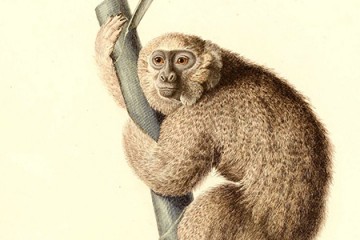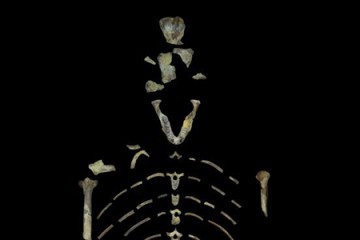The Jamaican monkey had a pretty sweet life on the island until people came along. At least, that is what recent carbon dating of the primate's fossils suggests. In a paper published in the Journal of Mammalogy, paleontologist and lead author Siobhán Cooke, who analyzed the new findings, writes that radiocarbon dating estimates the Xenothrix mcgregori monkey died off 1,477 years ago, plus or minus 34 years, or between 505 and 573. This time period provides the first evidence of the co-existence of X. mcgregori and humans on the island, meaning its extinction could be due to human causes.

Image caption: An artist’s sketch of the monkey Callicebus donacophilus, a living species closely related to X. mcgregori.
Image credit: Alcide Dessalines d'Orbigny, Voyage dans l'Amérique méridionale
Cooke, an assistant professor of functional anatomy and evolution at the School of Medicine, points out that understanding more about how early humans affected X. mcgregori can help scientists understand what we might be doing to native species, especially primates, right now. "This kind of work gives us a sense of the effects that human populations can have on the environment, which is certainly very relevant to this extinction that we are currently going through," she says, before adding, with a deadpan smile, "I'm very cheery."
She isn't being melodramatic.
A January 2017 study of global primate populations published in the journal Science Advances notes that roughly 60 percent of primate species are threatened with extinction and about 75 percent have declining populations, the result of increasing human pressure including habitat destruction and competition for resources.
X. mcgregori could offer a more detailed understanding of the human influence on primate habitats because of its uncommon history. A mainland primate, it somehow found its way to Jamaica millions of years ago. There were only a few other species on the island, such as early bats and rodents, none of which was its predator. In the ensuing millennia it evolved into a primate not found anywhere else: a bit more robust than mainland New World monkeys, probably weighing about 11 pounds, and moving slowly. Its dental fossils show that it lost a molar associated with its mainland kin, perhaps as a result of a mutation that occurred in a member of the founding population. "So it's interesting to know that there was some monkey that floated off on a raft of vegetation 7 million, 8 million years ago," Cooke says. "It gets on this island, there's like four other things there, and they're rodents. It just sits and eats its fruits and nuts, hangs out, and loses a couple of teeth [to evolution]. It's unique. And it's, quite frankly, not a bad life until these nasty humans come along."
There's still a fair amount of research needed to understand what exactly happened to Jamaica's unique monkey—testing more fossils' DNA to determine the genetic diversity of the species, etc.—but the study of the fossil record moves slowly. Radiocarbon dating is expensive and destroys the sample used, and, Cooke says, research funds for paleontology are difficult to come by since breakthroughs aren't as newsworthy as in the medical sciences and are less likely to be monetized as a future revenue stream.
Besides, just getting to understand what we know today took nearly a century. The monkey's remains were first discovered during fieldwork in 1919, but they sat around at the American Museum of Natural History until the 1950s, when two graduate students studied them. They provided the first description of the primate and named it. That work was all that was known about the monkey until more researchers took interest in it in the 1970s, which eventually led to more fieldwork uncovering additional remains in the 1990s. And it took another 20 years for carbon dating technology to get to the point of not requiring a great deal of material to return good data. An X. mcgregori sample was dated by Cooke's colleague at the University of California, Irvine, in 2014.
Cooke notes that the estimated extinction date she and her colleagues determined is one of the most recent for a primate in the fossil record. "But we don't have any evidence of anthropogenic extinctions of primates in the New World. This X. mcgregori radiocarbon-based date places it just at the point where humans are first coming to the island. It gives us a window into what humans may have done in the past, which hopefully would give us impetus to try to preserve remaining biological diversity today."
Posted in Science+Technology
Tagged paleontology









